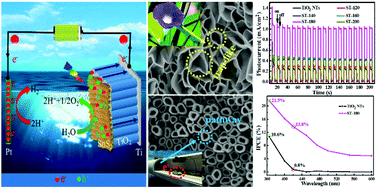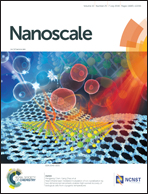Enhanced light trapping and high charge transmission capacities of novel structures for efficient photoelectrochemical water splitting†
Abstract
Excellent PEC efficiency, good reusability and the super stability of trap-like SnS2/TiO2 nanotube arrays (NTs)-based photoanodes are reported. Specifically, the SnS2/TiO2-180 °C (ST-180) photoanode exhibited the highest photocurrent density (1.05 mA cm−2) and an optimal η (0.73%) at 0.5 V (vs. SCE) under simulated light irradiation (AM 1.5G), which are 4.6 and 3.8 times higher than those of pure TiO2 NTs (0.23 mA cm−2 and 0.19%). The IPCE values of ST-180 can reach 21.5% (365 nm) and 13.8% (420 nm), which are much higher than those of pure TiO2 NTs (10.6% at 365 nm and 0.8% at 420 nm). The APCE values of the pure TiO2 NTs photoelectrode are 12.8% (365 nm) and 1.1% (420 nm), while the ST-180 values are 22.3% and 14.2%, respectively. Furthermore, the generation rates of H2 and O2 for the ST-180 photoanode are 47.2 and 23.1 μmol cm−2 h−1 at 0.5 V under AM 1.5G, corresponding to faradaic efficiencies of around 80.1% and 78.3%, respectively. In short, the high-efficiency PEC water splitting performance of this SnS2/TiO2 photoanode results from the enhanced light harvesting ability of the trap-like SnS2 structure, accelerated carrier transportation properties of TiO2 NTs, and effective carrier separation of the type-II heterojunction structure. This work may offer a combinatorial strategy for the preparation of heterojunction structures with high PEC performance and can be a model structure for similar photoanode materials.



 Please wait while we load your content...
Please wait while we load your content...